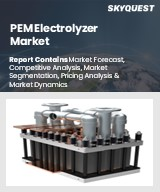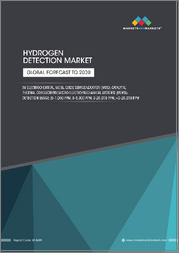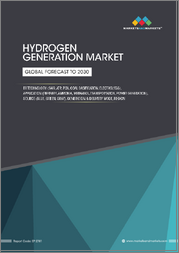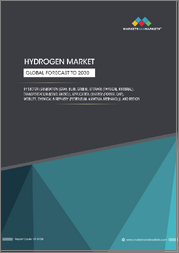
|
시장보고서
상품코드
1672165
세계의 타입 4 수소 실린더 시장 조사 보고서 : 산업 분석, 규모, 점유율, 성장, 동향 및 예측(2025-2033년)Global Type 4 Hydrogen Cylinder Market Research Report- Industry Analysis, Size, Share, Growth, Trends and Forecast 2025 to 2033 |
||||||
세계의 타입 4 수소 실린더 시장 규모는 2024년 11억 6,000만 달러에서 2033년 37억 2,000만 달러에 이르고, 2026년부터 2033년까지 예측 기간 동안 13.83%의 견고한 연평균 성장률(CAGR)을 나타낼 것으로 예상됩니다.
타입 4 수소 실린더 시장은 청정 에너지원으로서 수소에 대한 수요 증가와 효율적인 저장 솔루션의 필요성으로 인해 크게 성장할 것으로 예상됩니다. 복합재료로 만들어지고 고압 응용 분야를 위해 설계된 타입 4 실린더는 기존 강철 실린더에 비해 경량, 고강도, 안전성 향상 등 여러 가지 장점을 가지고 있습니다. 산업계와 정부가 운송, 에너지 저장 및 산업 응용 분야에서 수소 연료로의 전환을 우선시함에 따라 Type 4 수소 실린더에 대한 수요는 증가할 것으로 예상되며, 이 시장은 꾸준히 확대될 것으로 예상됩니다.
또한, 복합재료 및 제조 공정의 발전은 타입 4 수소 실린더 시장의 기술 혁신을 촉진하고 있습니다. 가볍고 내구성이 뛰어난 새로운 복합재료의 개발로 수소 저장 솔루션의 성능과 안전성이 향상되고 있습니다. 이러한 혁신은 수소의 운송 및 저장 효율을 향상시킬 뿐만 아니라 지속 가능한 에너지원으로서 수소의 전반적인 실행 가능성에 기여하고 있습니다. 타입 4 실린더의 새로운 소재와 설계에 대한 연구가 진행됨에 따라 성능과 안전성이 향상될 것으로 예상에 따라 시장은 더욱 확대될 가능성이 높습니다.
또한, 수소 인프라 개발에 대한 관심이 높아짐에 따라 타입 4 수소 실린더의 상황이 형성되고 있습니다. 정부와 민간 부문이 수소 충전소 및 유통 네트워크에 투자함에 따라 신뢰할 수 있고 효율적인 수소 저장 솔루션에 대한 수요가 증가할 것으로 예상됩니다. 이러한 추세는 기존 화석연료 자동차를 대체할 수 있는 청정 자동차로서 수소연료전지 자동차의 보급이 확대되고 있는 자동차 산업과 관련하여 특히 중요한 의미를 갖습니다. 제4종 수소 실린더 시장이 계속 진화하는 가운데, 기술 발전, 인프라 개발, 지속 가능한 에너지 솔루션에 대한 요구가 결합하여 미래의 궤도를 형성하는 데 중요한 역할을 할 것으로 보입니다.
당사의 보고서는 고객에게 다양한 산업 및 시장에 대한 종합적이고 실용적인 통찰력을 제공하기 위해 세심한 주의를 기울여 작성되었습니다. 각 보고서는 시장 상황을 완전히 이해하기 위해 몇 가지 중요한 요소를 포함하고 있습니다.
시장 개요 : 정의, 분류, 산업 현황 등 시장에 대한 자세한 소개.
시장 성장 촉진요인: 시장 성장에 영향을 미치는 주요 촉진요인, 억제요인, 시장 성장 촉진요인 및 과제를 상세하게 분석합니다. 이 섹션에서는 기술 발전, 규제 변화, 새로운 트렌드 등의 요인을 검토합니다.
세분화 분석 : 제품 유형, 용도, 최종 사용자, 지역 등의 기준에 따라 시장을 명확한 부문으로 분류합니다. 이 분석을 통해 각 부문의 성과와 잠재력을 파악할 수 있습니다.
경쟁 환경: 시장 점유율, 제품 포트폴리오, 전략적 이니셔티브, 재무 실적 등 주요 시장 기업에 대한 종합적인 평가. 주요 기업들이 채택하고 있는 경쟁 역학 및 주요 전략에 대한 고찰을 제공합니다.
시장 예측 : 과거 데이터와 현재 시장 상황을 바탕으로 일정 기간 동안 시장 규모와 성장 추세를 예측합니다. 여기에는 정량적 분석과 미래 시장 궤적을 보여주는 그래프 표시가 포함됩니다.
지역 분석 : 지역별 시장 성과를 평가하고 주요 시장 및 지역 동향을 파악할 수 있습니다. 지역 시장 역학 및 비즈니스 기회를 이해하는 데 도움이 됩니다.
새로운 트렌드와 기회: 현재 시장 동향과 새로운 시장 동향, 기술 혁신, 잠재적 투자 대상 분야를 파악합니다. 미래 시장 개척 및 성장 전망에 대한 통찰력을 제공합니다.
목차
제1장 서문
제2장 주요 요약
- 시장 하이라이트
- 세계 시장 현황
제3장 타입 4 수소 실린더 산업 분석
- 서론 - 시장 역학
- 시장 성장 촉진요인
- 시장 성장 억제요인
- 시장 기회
- 업계 동향
- Porter의 Five Forces 분석
- 시장의 매력 분석
제4장 밸류체인 분석
- 밸류체인 분석
- 원재료 분석
- 원재료 리스트
- 원재료 제조업체 리스트
- 주요 원재료 가격 동향
- 잠재적 바이어 리스트
- 마케팅 채널
- 직접 마케팅
- 간접 마케팅
- 마케팅 채널 발전 동향
제5장 세계의 타입 4 수소 실린더 시장 분석 : 재료별
- 재료별, 개요
- 재료별, 과거 및 예측 데이터 분석
- Inner Liner
- Composite Layer
제6장 세계의 타입 4 수소 실린더 시장 분석 : H2용량별
- H2용량별, 세계의 타입 4 수소 실린더 시장
- H2용량별, 과거 및 예측 데이터 분석
- 5Kg미만
- 5-10Kg
- 10-15Kg
- 15-20Kg
- 20Kg 이상
제7장 세계의 타입 4 수소 실린더 시장 분석 : 압력별
- 압력별, 개요
- 압력별, 과거 및 예측 데이터 분석
- <300 Bar
- 300-500 Bar
- 500-700 Bar
- >700 Bar 이상
제8장 세계의 타입 4 수소 실린더 시장 분석 : 용도별
- 용도별, 개요
- 용도별, 과거 및 예측 데이터 분석
- 수소 저장 인프라
- 수소 충전소
- 자동차용 연료전지
- 기타
제9장 세계의 타입 4 수소 실린더 시장 분석 : 최종 용도별
- 최종 용도별, 개요
- 최종 용도별, 과거 및 예측 데이터 분석
- 자동차 및 운송
- 에너지 및 전력
- 기타
제10장 세계의 타입 4 수소 실린더 시장 분석 : 지역별
- 지역별 전망
- 서론
- 북미의 판매 분석
- 개요, 분석과 예측
- 북미 부문별
- 북미 국가별
- 미국
- 캐나다
- 멕시코
- 유럽의 판매 분석
- 개요, 분석과 예측
- 유럽 부문별
- 유럽 국가별
- 영국
- 프랑스
- 독일
- 이탈리아
- 러시아
- 기타 유럽
- 아시아태평양의 판매 분석
- 개요, 분석과 예측
- 아시아태평양 부문별
- 아시아태평양 국가별
- 중국
- 인도
- 일본
- 한국
- 호주
- 동남아시아
- 기타 아시아태평양
- 라틴아메리카의 판매 분석
- 개요, 분석과 예측
- 라틴아메리카 부문별
- 라틴아메리카 국가별
- 브라질
- 아르헨티나
- 페루
- 칠레
- 기타 라틴아메리카
- 중동 및 아프리카의 판매 분석
- 개요, 분석과 예측
- 중동 및 아프리카 부문별
- 중동 및 아프리카 국가별 리스트
- 사우디아라비아
- 아랍에미리트(UAE)
- 이스라엘
- 남아프리카공화국
- 기타 중동 및 아프리카
제11장 타입 4 수소 실린더 기업 경쟁 구도
- 타입 4 수소 실린더 시장 시장 경쟁
- 제휴/협력/합의
- 인수합병(M&A)
- 신제품 발매
- 기타 개발
제12장 기업 개요
- 주요 기업의 시장 점유율 분석
- 시장 집중도
- Hexagon Purus
- Luxfer Holdings PLC
- Worthington Industries
- ILIIN Hysolus Co Ltd
- Toyoda Gosei Co Ltd.
- Faurecia
- Hanwha Cimarron
- OPmobilty SE
Global Type 4 Hydrogen Cylinder Market size is anticipated to grow from USD 1.16 Billion in 2024 to USD 3.72 Billion by 2033, showcasing a robust Compound Annual Growth Rate (CAGR) of 13.83% during the forecast period of 2026 to 2033.
The Type 4 hydrogen cylinder market is poised for significant growth, driven by the increasing demand for hydrogen as a clean energy source and the need for efficient storage solutions. Type 4 cylinders, which are made from composite materials and designed for high-pressure applications, offer several advantages over traditional steel cylinders, including lighter weight, higher strength, and improved safety. As industries and governments prioritize the transition to hydrogen fuel for transportation, energy storage, and industrial applications, the demand for Type 4 hydrogen cylinders is expected to rise, positioning this market for robust expansion.
Moreover, advancements in composite materials and manufacturing processes are propelling innovation within the Type 4 hydrogen cylinder market. The development of new lightweight and durable composites is enhancing the performance and safety of hydrogen storage solutions. These innovations not only improve the efficiency of hydrogen transport and storage but also contribute to the overall viability of hydrogen as a sustainable energy source. As research continues to explore new materials and designs for Type 4 cylinders, the market is likely to expand further, driven by the promise of enhanced performance and safety.
Additionally, the growing emphasis on hydrogen infrastructure development is shaping the Type 4 hydrogen cylinder landscape. As governments and private sectors invest in hydrogen refueling stations and distribution networks, the demand for reliable and efficient hydrogen storage solutions is likely to increase. This trend is particularly relevant in the context of the automotive industry, where hydrogen fuel cell vehicles are gaining traction as a clean alternative to traditional fossil fuel-powered vehicles. As the Type 4 hydrogen cylinder market continues to evolve, the combination of technological advancements, infrastructure development, and the need for sustainable energy solutions will play a crucial role in shaping its future trajectory.
Our reports are meticulously crafted to provide clients with comprehensive and actionable insights into various industries and markets. Each report encompasses several critical components to ensure a thorough understanding of the market landscape:
Market Overview: A detailed introduction to the market, including definitions, classifications, and an overview of the industry's current state.
Market Dynamics: In-depth analysis of key drivers, restraints, opportunities, and challenges influencing market growth. This section examines factors such as technological advancements, regulatory changes, and emerging trends.
Segmentation Analysis: Breakdown of the market into distinct segments based on criteria like product type, application, end-user, and geography. This analysis highlights the performance and potential of each segment.
Competitive Landscape: Comprehensive assessment of major market players, including their market share, product portfolio, strategic initiatives, and financial performance. This section provides insights into the competitive dynamics and key strategies adopted by leading companies.
Market Forecast: Projections of market size and growth trends over a specified period, based on historical data and current market conditions. This includes quantitative analyses and graphical representations to illustrate future market trajectories.
Regional Analysis: Evaluation of market performance across different geographical regions, identifying key markets and regional trends. This helps in understanding regional market dynamics and opportunities.
Emerging Trends and Opportunities: Identification of current and emerging market trends, technological innovations, and potential areas for investment. This section offers insights into future market developments and growth prospects.
SEGMENTATION COVERED IN THE REPORT
By Material
- Inner Liner
- Composite Layer
By H2 Capacity
- <5kg
510g
1015Kg
- 15-20Kg
- >20Kg
By Pressure
- <300Bar
300-500 Bar
500-700 Bar
- >700 Bar
By Application
- Hydrogen Storage Infrastructure
- Hydrogen Refueling Station
- Fuel Cell for Vehicles
- Others
By End-use
- Automotive & Transportation
- Energy & Power
- Others
- COMPANIES PROFILED
- Hexagon Purus
- Luxfer Holdings PLC
- Worthington Industries
- ILIIN Hysolus Co Ltd
- Toyoda Gosei Co Ltd.
- Faurecia
- Hanwha Cimarron
- OPmobilty SE
- The above list can be customized.
TABLE OF CONTENTS
1. PREFACE
- 1.1. Report Description
- 1.1.1 Objective
- 1.1.2 Target Audience
- 1.1.3 Unique Selling Proposition (USP) & offerings
- 1.2. Research Scope
- 1.3. Research Methodology
- 1.3.1 Market Research Process
- 1.3.2 Market Research Methodology
2. EXECUTIVE SUMMARY
- 2.1. Highlights of Market
- 2.2. Global Market Snapshot
3. TYPE 4 HYDROGEN CYLINDER INDUSTRY ANALYSIS
- 3.1. Introduction - Market Dynamics
- 3.2. Market Drivers
- 3.3. Market Restraints
- 3.4. Opportunities
- 3.5. Industry Trends
- 3.6. Porters Five Force Analysis
- 3.7. Market Attractiveness Analysis
- 3.7.1 Market Attractiveness Analysis By Material
- 3.7.2 Market Attractiveness Analysis By H2 Capacity
- 3.7.3 Market Attractiveness Analysis By Pressure
- 3.7.4 Market Attractiveness Analysis By Application
- 3.7.5 Market Attractiveness Analysis By End-use
- 3.7.6 Market Attractiveness Analysis By Region
4. VALUE CHAIN ANALYSIS
- 4.1. Value Chain Analysis
- 4.2. Raw Material Analysis
- 4.2.1 List of Raw Materials
- 4.2.2 Raw Material Manufactures List
- 4.2.3 Price Trend of Key Raw Materials
- 4.3. List of Potential Buyers
- 4.4. Marketing Channel
- 4.4.1 Direct Marketing
- 4.4.2 Indirect Marketing
- 4.4.3 Marketing Channel Development Trend
5. GLOBAL TYPE 4 HYDROGEN CYLINDER MARKET ANALYSIS BY MATERIAL
- 5.1. Overview By Material
- 5.2. Historical and Forecast Data Analysis By Material
- 5.3. Inner Liner Historic and Forecast Sales By Regions
- 5.4. Composite Layer Historic and Forecast Sales By Regions
6. GLOBAL TYPE 4 HYDROGEN CYLINDER MARKET ANALYSIS BY H2 CAPACITY
- 6.1. Overview By H2 Capacity
- 6.2. Historical and Forecast Data Analysis By H2 Capacity
- 6.3. Less than 5 Kg Historic and Forecast Sales By Regions
- 6.4. 5-10 Kg Historic and Forecast Sales By Regions
- 6.5. 10-15 Kg Historic and Forecast Sales By Regions
- 6.6. 15-20Kg Historic and Forecast Sales By Regions
- 6.7. More than 20 Kg Historic and Forecast Sales By Regions
7. GLOBAL TYPE 4 HYDROGEN CYLINDER MARKET ANALYSIS BY PRESSURE
- 7.1. Overview By Pressure
- 7.2. Historical and Forecast Data Analysis By Pressure
- 7.3. <300Bar Historic and Forecast Sales By Regions
- 7.4. 300-500 Bar Historic and Forecast Sales By Regions
- 7.5. 500-700 Bar Historic and Forecast Sales By Regions
- 7.6. >700 Bar Historic and Forecast Sales By Regions
8. GLOBAL TYPE 4 HYDROGEN CYLINDER MARKET ANALYSIS BY APPLICATION
- 8.1. Overview By Application
- 8.2. Historical and Forecast Data Analysis By Application
- 8.3. Hydrogen Storage Infrastructure Historic and Forecast Sales By Regions
- 8.4. Hydrogen Refueling Station Historic and Forecast Sales By Regions
- 8.5. Fuel Cell for Vehicles Historic and Forecast Sales By Regions
- 8.6. Others Historic and Forecast Sales By Regions
9. GLOBAL TYPE 4 HYDROGEN CYLINDER MARKET ANALYSIS BY END-USE
- 9.1. Overview By End-use
- 9.2. Historical and Forecast Data Analysis By End-use
- 9.3. Automotive & Transportation Historic and Forecast Sales By Regions
- 9.4. Energy & Power Historic and Forecast Sales By Regions
- 9.5. Others Historic and Forecast Sales By Regions
10. GLOBAL TYPE 4 HYDROGEN CYLINDER MARKET ANALYSIS BY GEOGRAPHY
- 10.1. Regional Outlook
- 10.2. Introduction
- 10.3. North America Sales Analysis
- 10.3.1 Overview, Historic and Forecast Data Sales Analysis
- 10.3.2 North America By Segment Sales Analysis
- 10.3.3 North America By Country Sales Analysis
- 10.3.4 United States Sales Analysis
- 10.3.5 Canada Sales Analysis
- 10.3.6 Mexico Sales Analysis
- 10.4. Europe Sales Analysis
- 10.4.1 Overview, Historic and Forecast Data Sales Analysis
- 10.4.2 Europe By Segment Sales Analysis
- 10.4.3 Europe By Country Sales Analysis
- 10.4.4 United Kingdom Sales Analysis
- 10.4.5 France Sales Analysis
- 10.4.6 Germany Sales Analysis
- 10.4.7 Italy Sales Analysis
- 10.4.8 Russia Sales Analysis
- 10.4.9 Rest Of Europe Sales Analysis
- 10.5. Asia Pacific Sales Analysis
- 10.5.1 Overview, Historic and Forecast Data Sales Analysis
- 10.5.2 Asia Pacific By Segment Sales Analysis
- 10.5.3 Asia Pacific By Country Sales Analysis
- 10.5.4 China Sales Analysis
- 10.5.5 India Sales Analysis
- 10.5.6 Japan Sales Analysis
- 10.5.7 South Korea Sales Analysis
- 10.5.8 Australia Sales Analysis
- 10.5.9 South East Asia Sales Analysis
- 10.5.10 Rest Of Asia Pacific Sales Analysis
- 10.6. Latin America Sales Analysis
- 10.6.1 Overview, Historic and Forecast Data Sales Analysis
- 10.6.2 Latin America By Segment Sales Analysis
- 10.6.3 Latin America By Country Sales Analysis
- 10.6.4 Brazil Sales Analysis
- 10.6.5 Argentina Sales Analysis
- 10.6.6 Peru Sales Analysis
- 10.6.7 Chile Sales Analysis
- 10.6.8 Rest of Latin America Sales Analysis
- 10.7. Middle East & Africa Sales Analysis
- 10.7.1 Overview, Historic and Forecast Data Sales Analysis
- 10.7.2 Middle East & Africa By Segment Sales Analysis
- 10.7.3 Middle East & Africa By Country Sales Analysis
- 10.7.4 Saudi Arabia Sales Analysis
- 10.7.5 UAE Sales Analysis
- 10.7.6 Israel Sales Analysis
- 10.7.7 South Africa Sales Analysis
- 10.7.8 Rest Of Middle East And Africa Sales Analysis
11. COMPETITIVE LANDSCAPE OF THE TYPE 4 HYDROGEN CYLINDER COMPANIES
- 11.1. Type 4 Hydrogen Cylinder Market Competition
- 11.2. Partnership/Collaboration/Agreement
- 11.3. Merger And Acquisitions
- 11.4. New Product Launch
- 11.5. Other Developments
12. COMPANY PROFILES OF TYPE 4 HYDROGEN CYLINDER INDUSTRY
- 12.1. Top Companies Market Share Analysis
- 12.2. Market Concentration Rate
- 12.3. Hexagon Purus
- 12.3.1 Company Overview
- 12.3.2 Company Revenue
- 12.3.3 Products
- 12.3.4 Recent Developments
- 12.4. Luxfer Holdings PLC
- 12.4.1 Company Overview
- 12.4.2 Company Revenue
- 12.4.3 Products
- 12.4.4 Recent Developments
- 12.5. Worthington Industries
- 12.5.1 Company Overview
- 12.5.2 Company Revenue
- 12.5.3 Products
- 12.5.4 Recent Developments
- 12.6. ILIIN Hysolus Co Ltd
- 12.6.1 Company Overview
- 12.6.2 Company Revenue
- 12.6.3 Products
- 12.6.4 Recent Developments
- 12.7. Toyoda Gosei Co Ltd.
- 12.7.1 Company Overview
- 12.7.2 Company Revenue
- 12.7.3 Products
- 12.7.4 Recent Developments
- 12.8. Faurecia
- 12.8.1 Company Overview
- 12.8.2 Company Revenue
- 12.8.3 Products
- 12.8.4 Recent Developments
- 12.9. Hanwha Cimarron
- 12.9.1 Company Overview
- 12.9.2 Company Revenue
- 12.9.3 Products
- 12.9.4 Recent Developments
- 12.10. OPmobilty SE
- 12.10.1 Company Overview
- 12.10.2 Company Revenue
- 12.10.3 Products
- 12.10.4 Recent Developments



















